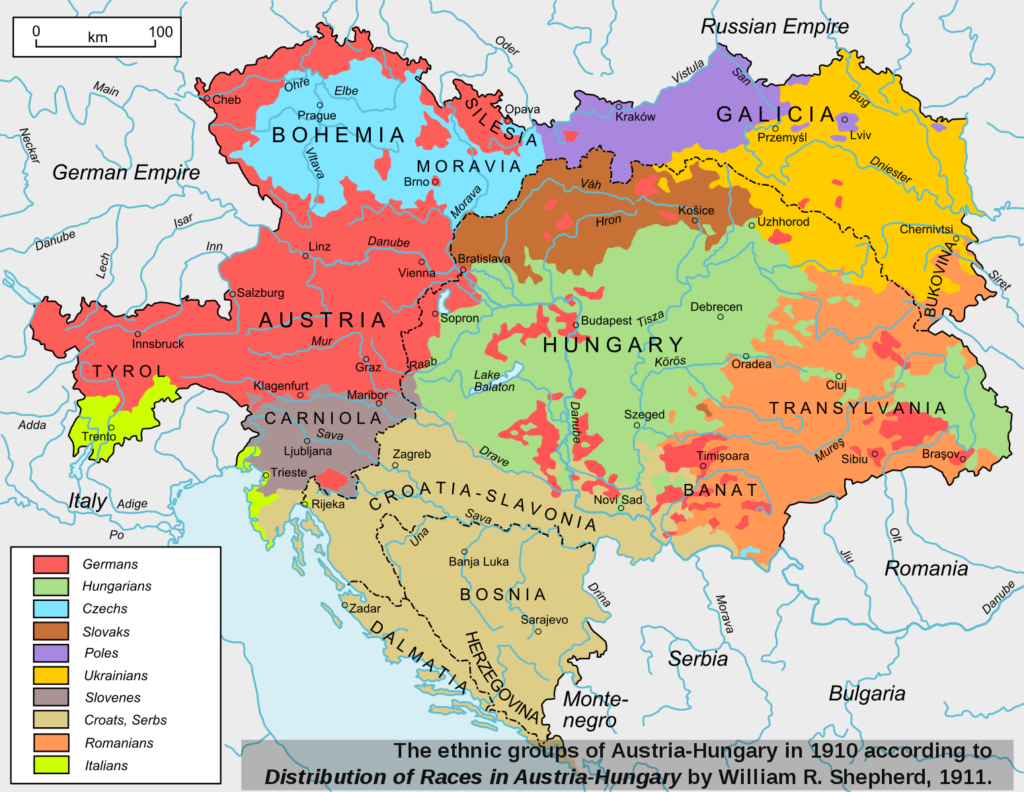Friday November 1st, 1918
Divisional attack. Raining hard. Went to Encores.
The Battalion is once again in training. Tomorrow, under an Operation Order released today, it will move towards the front line.
Meanwhile another of the Central Powers, this time Austria-Hungary, is preparing to leave the war. Austria-Hungary had started WWI when it declared war on Serbia in July 1914, but it won’t be there at the end.
Sometimes referred to as the Austro-Hungarian Empire or the Dual Monarchy it was a unique arrangement of countries and peoples and, as such, will result in a unique armistice.
Austria-Hungary
A multi-national state, Austria-Hungary was a constitutional union between the Austrian Empire and the Kingdom of Hungary. Together for just over 50 years, they formed the second largest country in Europe. They were ruled by the Hapsburg monarch who was both the Emperor of Austria and the King of Hungary. Each country had its own government.

While the two countries collaborated on foreign affairs and military matters, in other respects they were largely autonomous of each other. There were other ethnic groups within the coalition and certain regions, such as Polish Galicia and Croatia, enjoyed similar autonomy.
Rising nationalism, a badly managed war and an encouraging President Wilson have helped to bring these divisions to the surface in recent days.¹
Austria-Hungary prepares to leave the War
As AJP Taylor succinctly put it:
‘…Wilson had promised independence to the Czechs and Poles, less formally to the Rumanians and South Slavs. … This was the signal for revolt. The so-called ‘subject’ nationalities of Austria-Hungary learnt that they could escape the burden of defeat and become Allies merely by transforming themselves into independent nations. Naturally they did so…’ ²
‘The Hungarians and German Austrians were not so lucky. Though they had fought the war no more, and no less, than the other nationalities, they alone were treated as the heirs of the dead Empire and saddled with its guilt. They were compulsorily disarmed, charged theoretically with reparations. This was a strange distinction. Democratic Hungary and republican Austria paid a penalty for retaining their former imperial names.’³
Armistice
On November 2nd, a commentator in The Guardian reported:
‘..the political problems set up by the disintegration of the Dual Monarchy are perplexing and menacing. They are perplexing in the first place, because we no longer know with whom we have to deal. Presumably the generals in the field can make an armistice, but who can make peace?’†
This was prescient. The Austro-Hungarian High Command were the ones who sought an armistice. It will be signed on November 3rd, 1918 and enforced 24 hours later. Peace will come later.
9th Battalion War Diary – 1st November 1918 – Elincourt
Ref Maps – France, Valenciennes
Training and Lewis Gun Instruction. Operation Order No 14 issued, the Battalion will move to Maurois tomorrow (Appendix No 1).
References & Further Reading
¹ Austria-Hungary on Wikipedia
² ‘The First World War: An Illustrated History’ by AJP Taylor, Penguin, Kindle Locn 2523
³ ibid, Kindle Locn 2538
† The Guardian, November 2nd 1918, page 6
* Ethnic Map of Austria-Hungary by Andrein who has released it to the public domain. It is based on “Distribution of Races in Austria-Hungary” from the Historical Atlas by William R. Shepherd, 1911. The city names were changed to those in use since 1945. Wikimedia Commons


